-
Posts
3,797 -
Joined
-
Last visited
Content Type
Profiles
Forums
Events
Store
Posts posted by Jim Hargrove
-
-
According to the Warren Report, Bonnie Ray Williams was “a warehouseman temporarily assigned to laying plywood on the sixth floor.” [WCR p. 68]
-
David,
My granddaughter graduated from UofA at Tuscaloosa last year. She is now seeking a doctorate in Physical Therapy in Minnesota. Please consider visiting my website:
-
Thanks for responding, Tony. Can you show me evidence that any of the people in your four images above are either Bill Shelley or Billy Lovelady?
-

Some people believe that these frames from what John Butler has identified as the Couch-Darnell film show Bill Shelley and Billy Lovelady outside the TSBD (they are supposedly circled in red). The images appear to me to be nowhere near clear enough to make any such claim. But there is another problem....
The same day JFK was killed, Bill Shelley told the Dallas Police, "I went back to the building & went inside & called my wife & told her what happened. I was on the first floor then & I stayed at the elevator & was told not to let anyone out of the elevator." Four months later, on 3/18/64, Shelley told the FBI, "Immediately following the shooting, Billy N. Lovelady and I accompanied some uniformed police officers to the railroad yards just west of the building and returned through the west side door of the building about ten minutes later."
Where are the police in the frames above? You can see well ahead of the two circled men and well behind them. These two unidentified men do not appear to be accompanying any police officers.
-
On 2/20/2019 at 2:16 PM, Paul Jolliffe said:
Andrej,
Yes, the actual departure from the passenger elevator did pose a risk for the escaping assassins. However, John has posited that one of them, the brown coat man, in fact was seen leaving the TSBD on the Houston Street side by both James Worrell and Richard Carr. This man did not leave the TSBD via the front door and go down the front steps. After departing the TSBD, this man apparently then drove the Nash Rambler to the spot on Elm Street where he picked up a white-shirted man running down the slope, away from the southwestern side of the TSBD. That man (white shirt) was seen by Roger Craig, and Craig believed he witnessed the flight of (LHO) from the scene, abetted by the brown jacket man from the sixth floor of the depository.
(Now, I disagree with John about the post-assassination 2nd floor lunchroom encounter, but that is not the point here.)
The two men on the sixth floor - seen by at least five and perhaps as many as forty witnesses before the assassination - escaped somehow: they did not run down the back stairs, they did not run down the fire escape, and there is no good evidence that they came down one of the old, noisy, slow freight elevators, elevators whose open gates would have made them easy to spot by anyone as those elevators descended.
None of those are viable options.
John's floorboard escape to the passenger elevator theory is plausible. That's why I wonder if the (unstated) purpose of the floor-laying crew was to loosen the boards near the "sniper's nest" to facilitate the escape. I am not saying all or even any of that crew knew the purpose - merely that their work could well have been the cover needed to loosen the boards for the getaway, and to prevent any later investigators from realizing just what had happened around the southeast corner window, just above the 5th floor elevator shaft.
Andrej, your question about the risk the moment they stepped off the passenger elevator is legitimate, but not insurmountable for John's theory to be correct. I have more to say soon.
Meanwhile:
I'd like to ask the readership about the possibility/probability/certainty that the man with whom Marrion Baker came face-to-face (with the light brown jacket man, a 30 year old white man with dark hair, 5'9, 165 lbs), as described in Baker's first day affidavit, was, in fact the same man seen by Worrell, Carr, and Craig?
Good question! I’ve often thought that arguing about Baker’s alleged second floor encounter was largely irrelevant to this topic (since we’re talking about people escaping from the sixth floor after the hit, and Classic Oswald® wasn’t there).
But if Baker actually confronted the man seen by Worrell and Carr and perhaps Craig and others, it suddenly does become relevant. Skeptics will argue that Truly told Baker “he works here,” but... uh... let’s just say how remarkably brave Truly must have been to race up the stairs ahead of a cop ready to encounter armed assassins, unless he knew more than he let on!
For the time being, at least, John is going with the legitimacy of Baker’s second floor encounter, but he also points out that the second floor lunchroom had no outside windows and, if the overhead lights were out, it would have been pretty dark in there. The question of whether Baker actually encountered Oswald or the brown-coated man seen by Worrell and Carr is worthy of more discussion.
-
John,
Another researcher (not John) just wrote to me saying he was researching the plywood and 2 x 6 floor planks work being done at the time on the sixth floor and its position in relation to the elevator shaft beneath it.
-
Sandy,
OTOH, maybe the initial statements by Adams, Shelley, Lovelady, and Baker are all reasonably honest, and were changed later because of intimidation (in Vickie Adams' case) and fear of discovery in the plot (Shelley and Lovelady).
-
Tony,
I've gotten several messages from people saying the guys circled in your gif are Shelley and Lovelady, but I see no evidence for that.
-
If Adams’ Warren Commission testimony and statement to DPD detective James Leavelle are legit, then the two white men seen by Baker just seconds after Adams and Styles reached the first floor were obviously Shelley and Lovelady. If the statements are frauds, as many here seem to believe, then we must wonder who those two men were.
From a floor plan of the TSBD first floor, you can see that the second man Baker said was “20 or 30 feet away,” could be right in the vicinity of the electrical panel. Considering there were obvious questions about the power to all three elevators in the building, and power at least on the second, third, and fourth floors (the offices), an effort should have been made to identify these men.
Who could have easily identified them? Answer: Roy Truly, who accompanied Baker to the foot of the rear staircase. But, of course, he wasn’t asked. The only one who was asked was Baker, who was unfamiliar with TSBD employees.
If the two white men weren’t Shelley and Lovelady, who were they? And why did both Shelley and Lovelady, in later statements, claim it took them more and more time to re-enter the building? Their earliest statements indicated they went back inside the building quite quickly.
Thanks to all for this interesting discussion.
-
Sandy,
It’s very true that there is no mention of Shelley or Lovelady in Adams’ FBI report of 11/24. But we both know that the FBI altered statements of many different witnesses. I’m sure you will agree that the FBI reports are the LEAST reliable documents we have. But your analysis says that the Dallas cops and the Warren Commission attorneys conspired together to put words into Vickie Adams’ mouth about the location of Shelley and Lovelady at the bottom of the stairs.
It is certainly hard to know who to trust in this case, but I’ll take the Dallas cops and even the WC attorneys any day over the FBI. Wouldn’t you?
Here’s what John wrote about the FBI report you showed:
Victoria Adams was interviewed by the FBI on 11/24/63. The report read, "She and her friend (Sandra Styles) ran immediately to the back of the building to where the stairs were located and ran down the stairs. No one else was observed on the stairs at this time, and she is sure that this would be the only means of escape from the building from the sixth floor." Adams said, "Whenever anyone was on the stairs you could hear them on any floor. We would have heard someone on the stairs. Absolutely." Adams and Styles ran out of the building, turned to the left and ran across the railroad tracks...." The FBI altered statements of many witnesses, and so we don't know with certainty what Victoria Adams really told the FBI agents on 11/24/63, but this FBI report does not mention anything about Shelley or Lovelady.
-
A main theme of this write-up shows how everyone’s story changed over time. In both her Warren Commission testimony (marked “Top Secret”), which she allegedly corrected and signed, Adams wrote, “After the third shot, following that, the third shot, I went to the back of the building, down the back stairs, and encountered Bill Shelley and Billy Lovelady on the first floor on the way out to the Houston Street dock.” That is clearly at the back of the building near the electrical panels. She said essentially the same thing in her statement to Dallas Police. To Leavelle, she said, “The elevator was not running and there was no one on the stairs. I went down to the first floor. I saw Mr. Shelley and another employee named Bill. The freight elevator had not moved, and I still didn’t see anyone on the stairs.”
In Shelley’s affidavit he mentions meeting Gloria Calvery in the little island between the Elm Streets, but that’s just a few feet from the front door of the Book Depositoy. Then he went back into the building, called his wife (he said) and then he indicated that “I stayed at the elevator,” just where Adams said she saw him in her earliest accounts.
In Lovelady’s affidavit, he said that after the shots “we went back into the building….”
None of this contradicts Adams’ original statements, other than Shelley (possibly) calling his wife. After the earliest statemenst though, everyone’s story began to change. Before long, Lovelady told the WC that he walked all the way to the railroad tracks and Shelley claimed he was still outside the building when Truly and Baker walked in.
Vickie Adams told author Barry Ernest that she was followed and harassed for a long time after the assassination, and she eventually, we think, saw the fate in store for her and changed her story as well. She had ample reason to be afraid. As John wrote: “In January 1979, near the end of the HSCA hearings, Billy Lovelady died of a heart attack at age 41. His wife, Patricia, refused to discuss his death except to say, ‘I have been harassed for 15 years, and I'm not going to be harassed any more.’" The story was reported in the New York Times, Jan. 19, 1979, page 15.
-
To Paul ...
Both John and I have looked at 6th floor TSBD photos from ‘63 trying to see if new wood or cut boards could be seen anywhere near the area that would likely be above the passenger elevator shaft. We haven’t been able to come up with much, but, of course, the visual data is limited.
In my opinion, at least, Truly’s decision to move past the passenger elevator might well be for the reason you describe, or might, as John has suggested, also be because he knew the power was off to the elevator and that the front stairs only provided access to the 2nd floor and the basement.
To Ron ...
You're probably already familiar with this, but to show the location of the 1st floor electrical panels, the two freight elevators and the rear stairs, here’s an excerpt from Escape from the Sixth Floor:
Below is a diagram of the 1st floor of the Book Depository showing the position of Baker and Truly (red line). One of the two men was standing near the freight elevators (yellow), the only access to the 6th floor when the electricity is off. The other man, according to Officer Baker, was "20 or 30 feet away," and likely standing very close to the buildings electrical panels (purple). If these two men were Bill Shelley and Billy Lovelady, as seen and identified by Victoria Adams and Sandra Styles only moments earlier, then Roy Truly knew both men very well. Truly either knew, or probably knew, they were responsible for turning off the electricity, which is why Truly ignored the passenger elevator, failed to look at the electrical panels, ignored the two men, said nothing to anyone about these two men, and ran up the wooden stairs with Officer Baker.
QUESTION: The President of the United States was shot moments earlier. Why would Roy Truly, or any unarmed citizen, race up the stairs in order to find and confront one or more armed assailants who would likely have shot him on sight? Truly's actions imply that he knew for a fact there was no reason to fear such a confrontation.
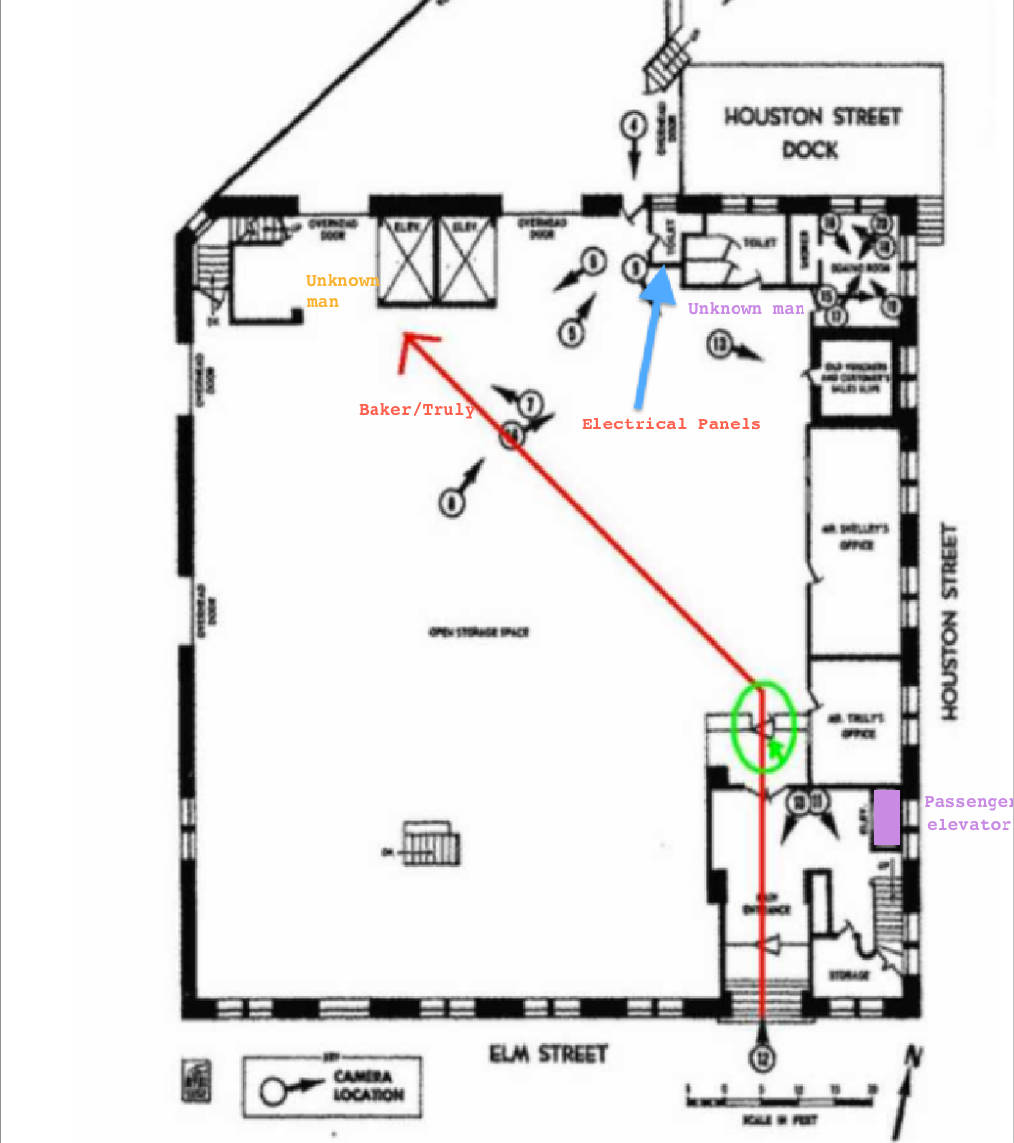
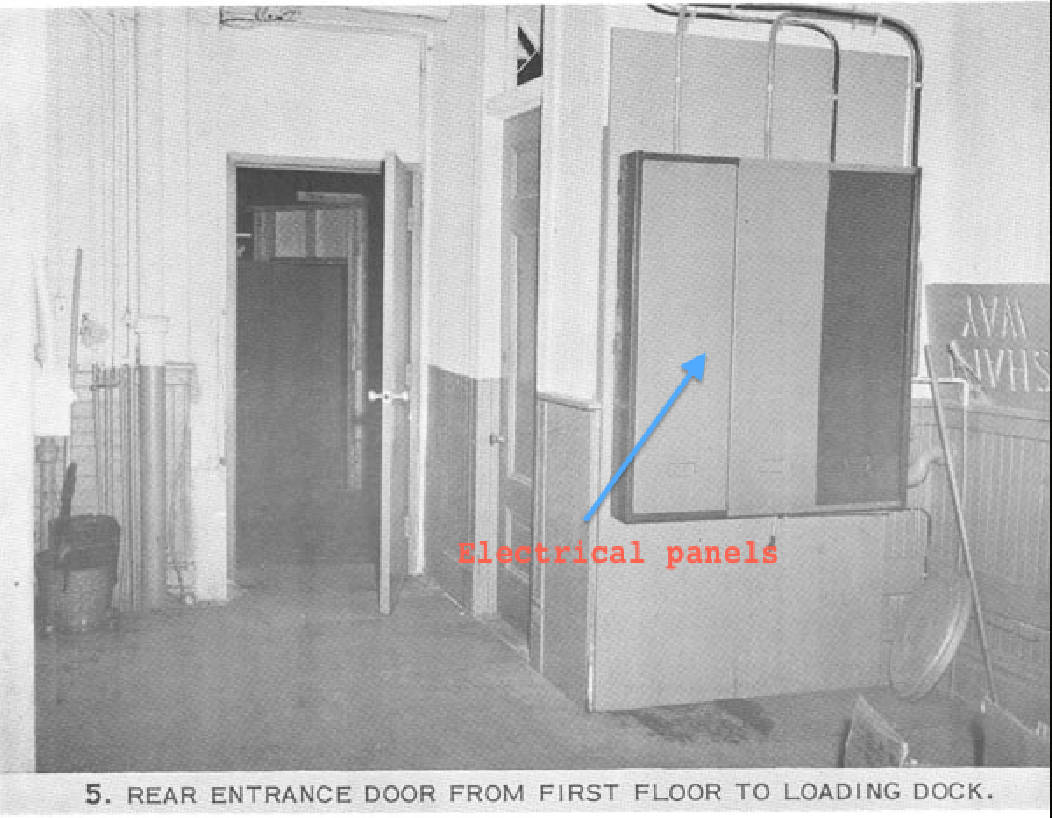
-
Ron,
How 'bout RX-ZIM as CIA cryptonym for the Oswald Project prior to 11/22/63? From CIA Tokyo-based accountant James Wilcott....
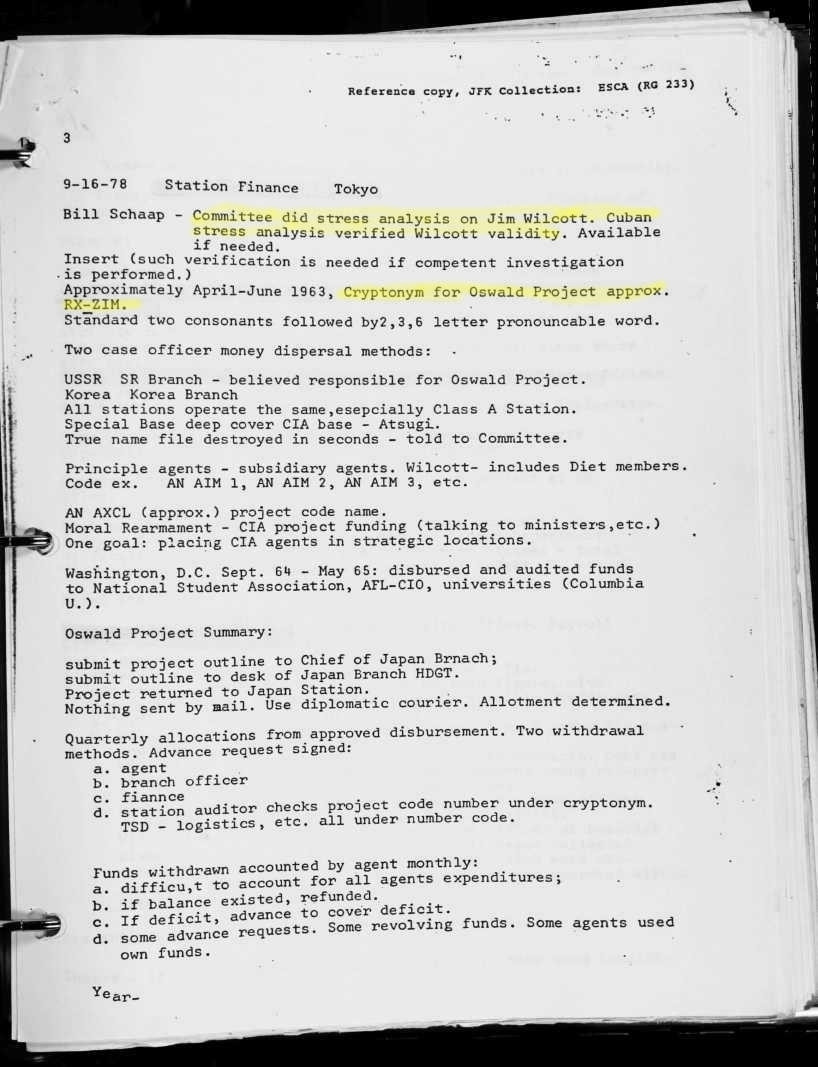
Check out the following link for more HSCA staff notes on CIA's Wilcott's backgrounders....
https://harveyandlee.net/Wilcott/Wilcott_Notes.html
Wilcott's full secret HSCA testimony is here:
https://harveyandlee.net/Wilcott/Wil_full.htm
-
To John B: Thanks for the "Top Secret" graphic on Adams’ WC testimony. We have added it to the Escape from the Sixth Floor page.
To Ron B: Thanks also for the “power was off” quotes from The Girl on the Stairs. John talked at length to author Barry Ernest and he is sending me the book.
To Paul J: John sent me a copy of his reply to your email. Do you want to discuss it here?
Recently added to Escape from the Sixth Floor:
The Warren Commission knew the electricity had been shut off minutes before the shooting and turned back on minutes after the shooting. This is not only very suspicious but suggestive of a conspiracy. The Commission had photographs of the electrical panels on the first floor and knew there were men nearby about one minute before and one minute after the shooting. Why was the Commission not interested in the identity of these two men, who were at the back of the TSBD near the electrical panels and near the only means of escape from the the 6th floor one minute after the shooting? Why did the Commission fail to ask Roy Truly if he knew either of these men? Because the Commission's assignment was to conclude that one man, Lee Harvey Oswald, shot and killed President Kennedy---with no accomplices.
-
The TSBD electrical wiring is complicated, and we only know part of it.
John said the building was built in the 1890s and originally wired for electricity in the 1920s. In 1961 the 2nd, 3rd, and 4th floors were remodeled as offices and rewired, with the addition of air conditioning and the passenger elevator near the front of the building. There were thus two different sets of wiring and two different electrical boxes.
From the comments by Geneva Hine, Vickie Adams and others it is clear that at least some of the electric power in the building was cut off, probably twice—once during the hit and again a few minutes later). Depending on how the power was cut, the floors above the 4th floor may have continued to have power while the electricity to the elevators and offices was cut. This is just a guess, but clearly power to large parts of the building was turned off during the assassination.
-
To Paul J – Thanks for your interesting note above. Since you and John communicate frequently, you may have already sent this to him, but in case you haven’t, I’ll take the liberty of sending it his way.
To John B – Thanks for the “top secret” version of the Adams’ testimony!
To Bart K – Adams’ earliest statements seem to show that she encountered both Shelley and Lovelady at the bottom of the stairs. After unending abuse, she eventually changed her story entirely. So did Shelley and Lovelady. The changing stories is one of the main points of John’s new write-up.

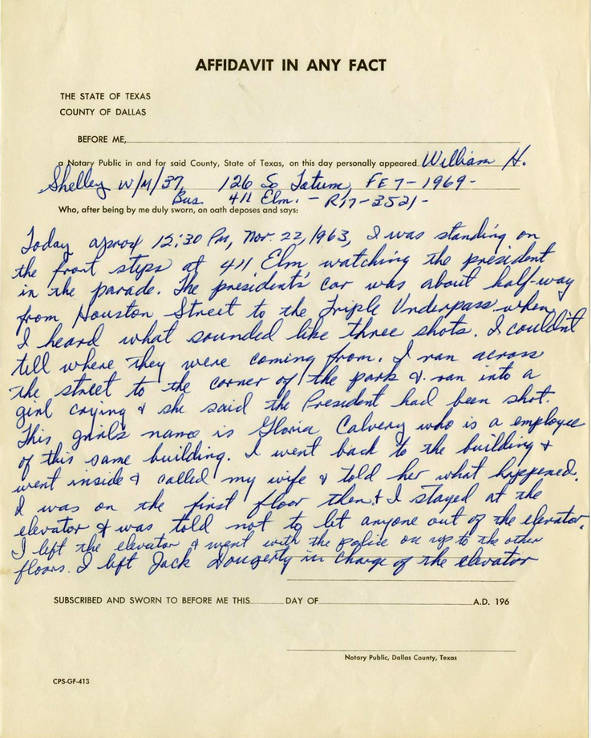
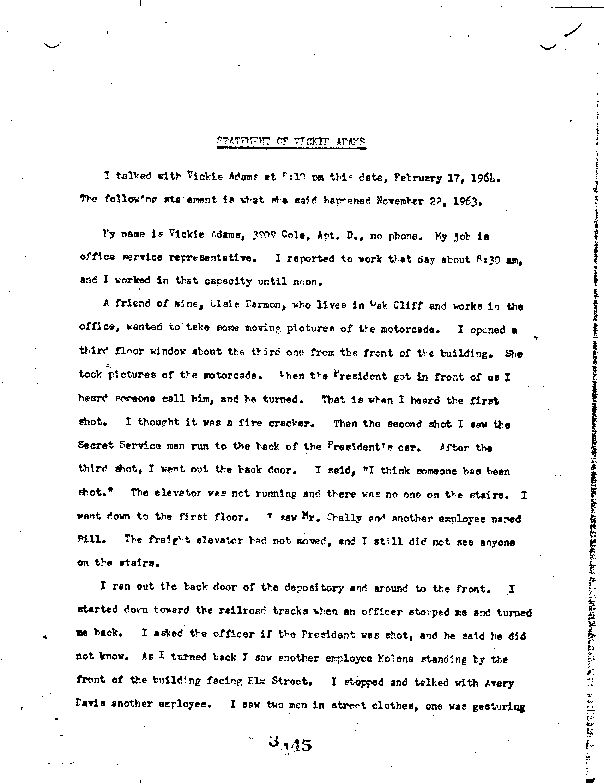
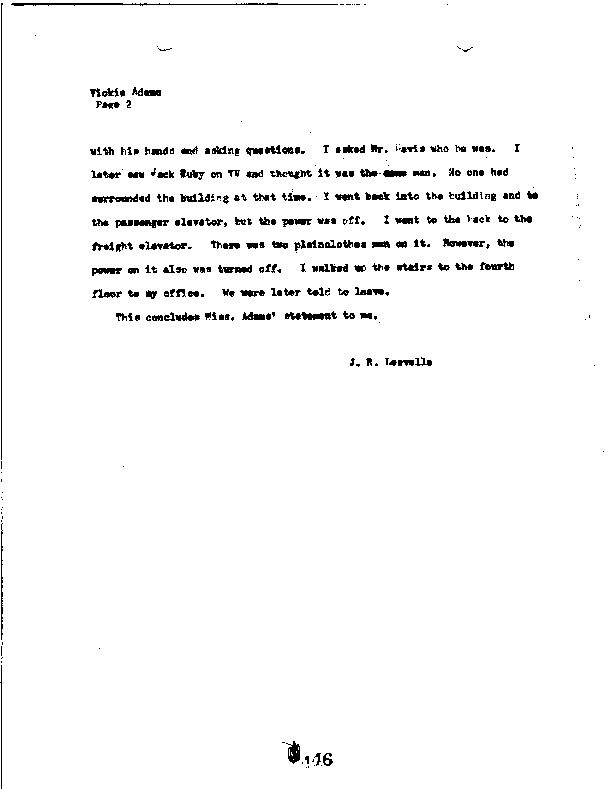
-
The timing is everything here. From Mrs. Hine’s testimony, it seems that the lights went out just as the escort car in the motorcade turned from Main St. onto Houston. We think the electricity was off for only a minute or two, just enough time for the 6th floor assassin(s) to escape through the floor boards into the freight elevator shaft and the elevator itself.
-
2 hours ago, Ron Ecker said:
Well I'm just going from memory, but I thought that the electricity in the building never went out. This assumption was made because one of the ladies said the lights went out on the phone, meaning that there were no phone calls made as the motorcade approached, therefore no phone extension lights were lit. But my memory has been faulty before.
Yes, I’ve heard that argument also. But numerous witnesses also observed that the power went out to both the passenger elevator in the front of the building and the two freight elevators at the back. That is quite a coincidence, no?
The witness who said “The lights all went out and the phones became dead” was Geneva Hine, whose interior office was reasonably distant from the windows and had long rows of ceiling lights.

John discovered that Western Electric supplied the multi-line phones via AT&T, and the Lucite buttons on the phones were lit by the building’s electrical service, not the small amount of current carried in the phone lines. The TSBD received orders from all over the U.S. and Texas, not just Dallas, and there would be no reason for all calls to stop immediately because of what was happening in Dealey Plaza.
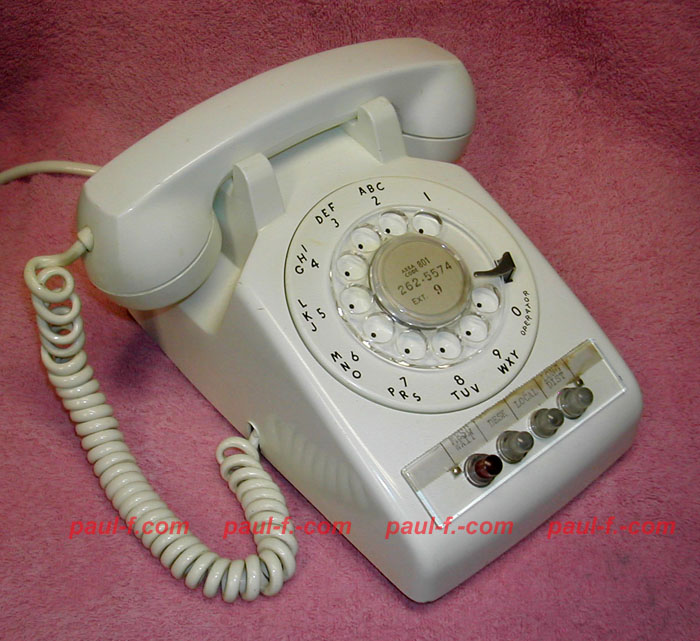
Like so much else in this case, this gets complicated quickly because the power seems to have been shut off on two separate occasions.
-
Looking for references to CIA cryptonym RX-ZIM [from James Wilcott's HSCA backgrounder on LHO].

-
The man Americans know as “Lee Harvey Oswald” wasn’t on the 6th floor of the Book Depository at the time JFK was killed. Although numerous witnesses saw two men on the 6th floor just before the shooting, both men apparently escaped unseen and unheard at just about time the electricity went off in the building.
Shelley and Lovelady were at the bottom of the rear stairs near the electric panel when the electricity in the building was shut off. Young Vickie Adams was running down the rear stairs just before Baker and Truly charged up them, apparently to encounter Oswald entering the lunch room (probably arriving from his position outside the front of the building, where he would use the front staircase to go up to the lunch room, explaining why no one saw him on the rear staircase). Roy Truly charged up the stairs ahead of Baker without any apparent fear whatsoever of running into an armed assassin.
Victoria Adams was hounded for years because she said she didn't encounter "LHO" on the rear staircase, and she should have if the Warren Commission version was correct. Shelley and Lovelady distanced themselves ever farther from the TSBD electrical panel for months after their initial statements.
John A. has been working on an important update to his “Escape from the Sixth Floor” page on my website for several weeks. I just uploaded his latest material a few hours ago. This is a phenomenal read! To see most of just the latest updates, click on the link below.
https://harveyandlee.net/TSBD_Elevator/TSBD_elevator.html#Electricity
To read “Escape from the Sixth Floor” in it’s entirety, click below:
-
It has always been my opinion that the image on the TSBD stairs is not clear enough to positively identify it as Oswald.
But the discovery of Hosty’s note saying that Oswald said he went outside to watch the parade is significant no matter what excuses the usual naysayers offer us.
WC apologists here tell us Oswald was lying to hide his guilt in the assassination. Really? He was so stupid that he shot the President from his own workplace and hoped to get away with it?
Not likely. Researchers who want to destroy the position of the WC apologists should post, again and again, proof of how much of the so-called “evidence” against LHO in the National Archives is clearly phony. This was an elaborate set-up, an enormous cover-up, and Oswald was, just as he said he was, a patsy.
Megathanks to Bart Kamp for promoting this important discovery.
-
3 hours ago, Tony Krome said:
Which brings me to the point of this topic : they select a patsy with no motive. This, combined with sketchy evidence, cover ups, untimely deaths and contradictions that ensued post-assassination, leads me to believe that Oswald was not their ideal or prime candidate on the day.
A perfect operation would have left no room for doubt. Something went so wrong, they seemed to have "eaten one of their own" and were forced to utilise their fallback patsy in double quick time, then tried to fit a square peg in a round hole.
With his trip to Russia, staged FPCC activities, and commie-loving history going all the way back to the Marine Corps, it was easy to paint the Russian-speaking Oswald as a commie with ties to Castro. The main object of the assassination was probably to provoke an invasion of Cuba, which LBJ may have prevented by ordering the cover-up.
Oswald’s ties to both the FBI and the CIA made G-men, especially J. Edgar Hoover, all too happy to enter full scale cover-up mode.
Russian-speaking Oswald had demonstrated that he would follow even difficult orders, critical in the days and hours before and immediately after the assassination. (He absolutely had to be in the right places at the right times to become a successful patsy. And a patsy was absolutely critical for the plot to succeed. Without one, the search for the plotters would have been relentless.)
The “Harvey and Lee” project made it simple to send around a fellow who looked like Russian-speaking Oswald in the weeks prior to the hit to set him up as the assassin-to-be. For example….
- The Sports Drome Rifle Range on Oct. 26, Nov. 9, Nov. 10, and again on Nov. 17, several times creating a scene and once shooting at another guy's target;
- Morgan's Gun Shop in Fort Worth on Nov 2.
- The Downtown Lincoln Mercury dealership also on Nov. 2 where he test drove a car at wrecklessly high speeds saying he would soon come into enough money to buy a new car.
- The Irving Furniture Mart On Nov. 6 or 7 for a gun part where he was referred to the shop where Dial Ryder worked.
- The Southland Hotel parking garage (Allright Parking Systems) on Nov. 15 to apply for a job and oh-so-subtly ask how high the Southland Building was and if it had a good view of downtown Dallas.
- Hitchhiking on Nov. 20 on the R.L. Thornton Expressway while carrying a 4-foot long package wrapped in brown paper and introducing himself to Ralph Yates as “Lee Harvey Oswald.” He discussed the President's visit, wondered if you could shoot a president, and asked to be dropped across the street from the Texas School Book Depository (where Russian-speaking “Lee Harvey Oswald” was already at work).
- The 1973 motion picture “Executive Action” with Burt Lancaster and Robert Ryan does a great job showing how an “Oswald” look-alike traveled around Dallas in the weeks before the assassination doing many of the things listed above.
-
Fascinating....
According to Mr. Barbour, these newly released files were originally sent by Jim Garrison to the HSCA (which, I would assume, buried them). They were ordered destroyed by Harry Connick, Sr. when he became New Orleans DA after Garrison.
I'd also like to know more about the mechanics of his newly released material. Will the documents be posted online? I sure hope so.
“Let justice be done though the heavens fall!”
-
Remarkable! You can download the whole thing in just about any format. I chose PDF.
Megathanks, Paul!


“The lights all went out,” and the elevators stopped while JFK was murdered. Shelley and Lovelady were near the bottom of the back staircase, by the electrical panel... and Vickie Adams saw them ... until everyone's story changed...
in JFK Assassination Debate
Posted
Paul,
Despite the FBI report, according to this unsourced note on the Mary Ferrell database, “Herbert Lee” was living at 1026 N. Beckley on 11/22/63.
https://www.maryferrell.org/marysdb.html?id=943
Don’t know if that could be a reference to “O.H. Lee” or “Herbert Leon Lee” but my bet is that the Russian-speaking Oswald was under close surveillance in the days leading up to the assassination, at N. Beckley, at the TSBD, and, of course, at Ruth Paine’s, at a minimum. He just had to be in the right places at the right times to be a successful patsy.
Part of what led John to his theory of the floorboard escape above the front elevator was simply a process of elimination. If the 6th floor assassins didn’t come down the back stairs, and since the front stairs didn’t go up to the 6th floor, and since they surely would have been seen by many people on the outdoor fire escape, and since the freight elevators had see-through walls, what other escape routes were left?